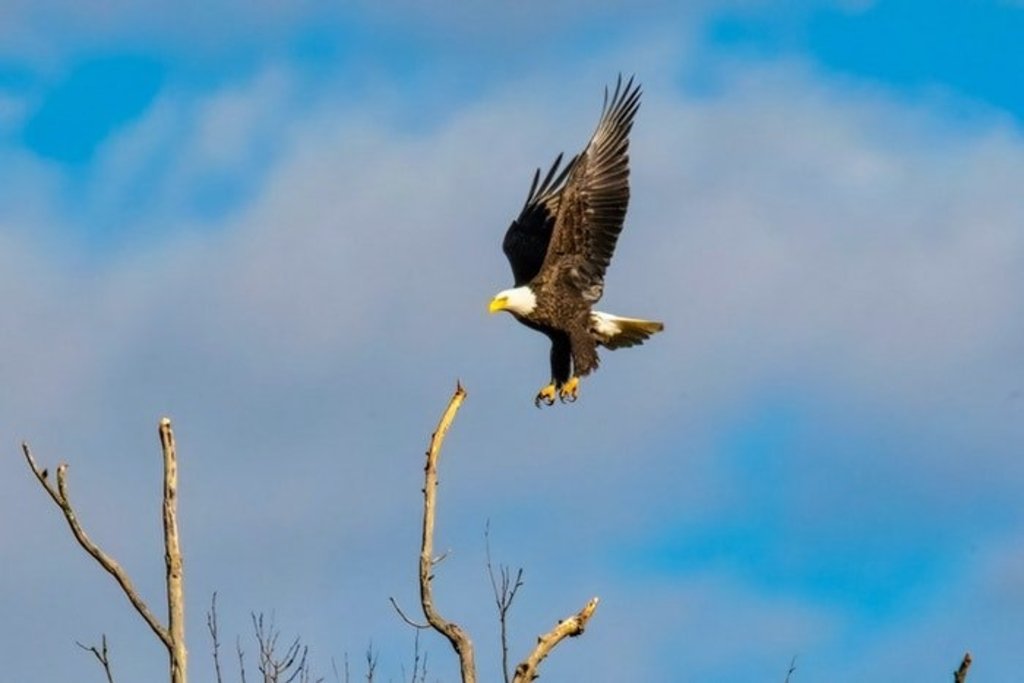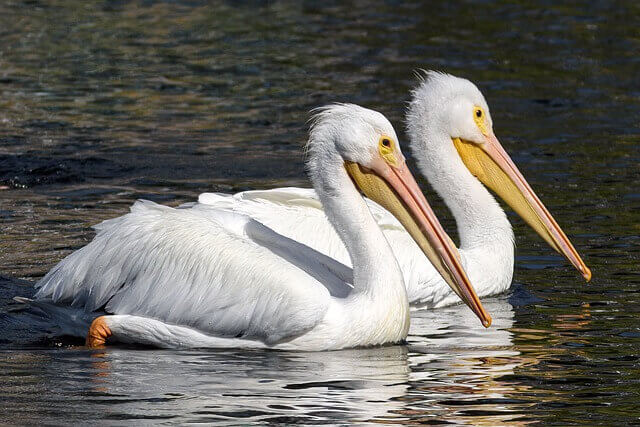Get ready to spread your wings and embark on a fascinating avian adventure as we uncover the secrets of the largest migratory birds in Canada!
From majestic flights spanning thousands of miles to quirky behaviors that will leave you in awe, these feathered travelers are the true globetrotters of the avian world.
Discover the astounding diversity and incredible journeys of Canada’s migratory giants in this captivating exploration. Let’s dive in!
Table of Contents
The Canada Goose
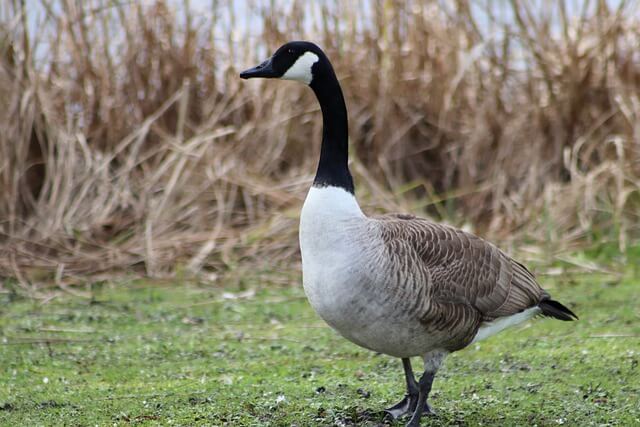
The Canada Goose (Branta canadensis) is a distinguished migratory bird known for its iconic presence in North America. In this section, we will delve into the fascinating characteristics of the Canada Goose.
Appearance and Size
The Canada Goose is a large bird with a distinctive appearance. It has a robust body covered in brown feathers, a black neck, and a white chinstrap marking that extends up the sides of its face.
Its wings are broad and exhibit a unique pattern of black and white feathers. On average, Canada Geese measure between 30 and 43 inches in length and have a wingspan ranging from 50 to 71 inches.
Migratory Behavior
Canada Geese are known for their remarkable migratory journeys. They are highly adaptable and can be found in various habitats, including lakes, rivers, fields, and urban areas.
During the spring and fall, these geese undertake long-distance migrations between their breeding grounds in northern regions and their wintering grounds in southern areas.
Their migration routes often span thousands of miles, with some populations even traveling from Canada to the United States.
Social Structure and Vocalizations
Canada Geese are social birds that form strong pair bonds and exhibit cooperative behavior within their flocks. They communicate through a range of vocalizations, including honks, hisses, and various calls.
These vocalizations play an essential role in maintaining group cohesion and signaling potential threats or territorial boundaries.
Diet and Feeding Habits
Canada Geese are primarily herbivorous, feeding on a wide range of plant materials, including grasses, sedges, and agricultural crops.
They often graze on land or venture into water bodies to forage on aquatic vegetation. In urban areas, they may also consume human-provided food, such as grass on lawns or bread crumbs in parks.
It is important to note that feeding them human food can disrupt their natural diet and lead to negative consequences for their health.
Conservation Status and Management
Canada Geese have adapted well to human-altered landscapes and have experienced population growth in many areas.
While they are not currently considered a threatened species, their abundance in some regions has led to management challenges, particularly in urban and agricultural areas where conflicts arise with human activities.
It is crucial to strike a balance between appreciating and managing Canada Geese populations to ensure coexistence with humans and the conservation of their natural habitats.
Conclusion
The Canada Goose’s distinct appearance, migratory behavior, social structure, and adaptability make it a fascinating species to study and admire.
As we encounter these majestic birds in various environments, it is essential to appreciate their ecological role and contribute to their conservation efforts, ensuring the continued presence of these iconic birds in the North American landscape.
The Turkey Vulture
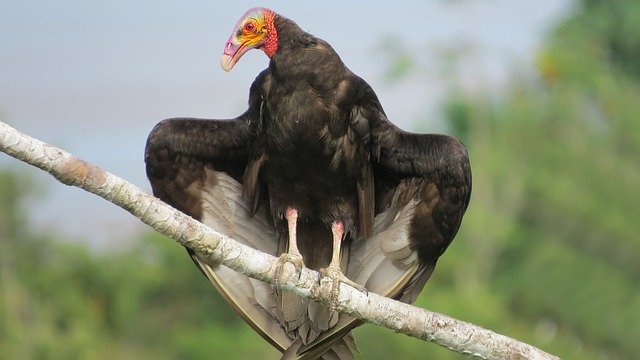
The Turkey Vulture (Cathartes aura) is a remarkable bird known for its scavenging capabilities and distinctive appearance. In this section, we will delve into the fascinating characteristics of the Turkey Vulture.
Size and Appearance
The Turkey Vulture is a large bird with a wingspan ranging from 5 to 6 feet, making it one of the largest vultures in North America.
It has dark brown to black feathers covering its entire body, while its bare head and neck exhibit a vibrant red color.
The Turkey Vulture has long, broad wings, a short tail, and a hooked beak that is adapted for tearing flesh.
Scavenging Behavior
Turkey Vultures are highly specialized scavengers, primarily feeding on carrion. Their keen sense of smell allows them to detect the scent of decaying flesh from great distances.
These vultures play a vital ecological role by cleaning up carcasses and preventing the spread of diseases.
Flight and Soaring Abilities
Turkey Vultures are masters of soaring flight, utilizing thermals and updrafts to effortlessly glide through the skies.
They have long, broad wings that enable them to maintain flight for extended periods without much flapping. By riding the thermals, they can cover vast distances while conserving energy.
Social Behavior and Roosting
Turkey Vultures are typically gregarious birds, often roosting and nesting in large groups. They form communal roosts, gathering in trees, abandoned buildings, or other elevated structures.
These roosts can contain hundreds of vultures, providing them with safety and social interaction.
Migration Patterns
Turkey Vultures are migratory birds, with populations in North America undertaking seasonal journeys.
They migrate south during winter months to take advantage of warmer climates and abundant food sources.
The timing and routes of their migration can vary depending on the region.
Conservation Status
Turkey Vultures are generally widespread and not considered globally threatened.
However, they face some challenges, including habitat loss, poisoning from ingesting lead ammunition in carcasses, and collisions with vehicles.
Efforts to protect their habitats and raise awareness about the importance of these scavengers are crucial for their long-term conservation.
Conclusion
The Turkey Vulture’s role as a scavenger and its unique aerial abilities make it a fascinating species to study.
With its impressive wingspan, scavenging behavior, soaring flight, and migratory nature, the Turkey Vulture showcases the marvels of nature’s adaptations.
Understanding and appreciating these remarkable birds contribute to their conservation and the ecological balance they help maintain.
The Golden Eagle
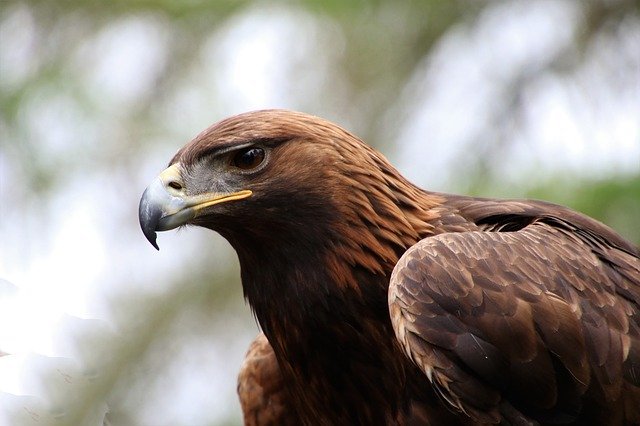
The Golden Eagle (Aquila chrysaetos) is one of the world’s largest aerial predators and a prominent species found across various regions.
Recognized as the “Eagle of the Sky,” this majestic bird has captivated hunters and enthusiasts for centuries. In this section, we will explore the fascinating characteristics of the Golden Eagle.
Size and Appearance
The Golden Eagle is indeed one of the largest birds of prey in the Northern Hemisphere, belonging to the Accipitridae family.
It has a dark brown upper body, contrasting with white underparts and a yellowish-white belly. Its long legs feature black-tipped feathers, and it possesses a short bill.
The wingspan of the Golden Eagle extends approximately 6 to 7 feet, while their body length measures around 30 to 40 inches.
Hunting and Adaptability
These magnificent raptors possess sharp talons ideally suited for capturing prey while in flight. Their large, powerful talons enable them to secure and catch sizable animals.
Golden Eagles are highly adaptable and can inhabit diverse environments, ranging from forests to open plains.
They undertake migratory journeys each year, seeking out wintering grounds and nesting areas. During the spring, they establish nests and lay eggs, primarily feeding on grass seeds.
The number of nests can vary, with some pairs having only one nest and others having multiple nests, even exceeding fifty.
Predatory Behavior and Diet
While the Golden Eagle consumes carrion, it exhibits heightened predatory behavior during the breeding season. Although smaller birds are preyed upon, Golden Eagles are capable of taking down larger animals as well.
They have been observed feeding on animals like squirrels, rabbits, swallows, woodpeckers, hawks, and falcons.
Unique Flying Abilities
Unlike some birds that rely on wing movements to fly, Golden Eagles possess the remarkable ability to hover and land without flapping their wings.
This unique feature allows them to glide effortlessly over land and water, facilitating long-distance travel. They can also remain submerged underwater for extended periods.
Migration Patterns
The Golden Eagles’ migration pattern in Canada is an extraordinary spectacle to behold. These majestic birds embark on long-distance journeys across the country, guided by their innate navigational abilities.
Golden Eagles in Canada primarily breed in the northern regions during the summer months.
As winter approaches, they undertake southward migrations, seeking out more favorable wintering grounds in southern Canada or even venturing further south into the United States.
Their migration routes often follow mountain ranges, river valleys, and other topographical features that provide thermals and updrafts for efficient soaring and energy conservation.
Witnessing the sight of Golden Eagles soaring through the Canadian skies during their migration is a testament to their remarkable strength and resilience.
Conservation Status
Golden Eagles are widely distributed, but they face various threats, including habitat loss, human disturbance, and illegal hunting.
It is essential to protect and conserve their habitats to ensure their continued survival.
Conclusion
By exploring the remarkable characteristics of the Golden Eagle, we gain a deeper appreciation for these magnificent creatures and their vital role in our natural ecosystems.
The Golden Eagle’s impressive size, hunting abilities, adaptability, and unique flying skills make it a truly remarkable species worth cherishing and protecting.
The Great Blue Heron
The Great Blue Heron (Ardea herodias) is a magnificent waterbird known for its elegance and striking appearance. In this section, we will delve into the captivating characteristics of the Great Blue Heron, including its migration patterns into Canada.
Size and Appearance
The Great Blue Heron is one of the largest heron species in North America. It possesses a tall and slender body, with a height ranging from 3 to 4.5 feet.
The wingspan of the Great Blue Heron can extend up to 6.6 feet, making it an impressive sight in flight. It features long legs and a long, pointed bill perfectly adapted for its feeding habits.
Distinctive Features
This waterbird exhibits a blue-gray plumage on its body, with a black stripe extending from its eyes down its neck.
The Great Blue Heron has a white face, chest, and belly, which contrast beautifully with its dark blue-gray feathers.
During the breeding season, it develops long, delicate plumes on its head and back, adding to its regal appearance.
Habitat and Migration Patterns
The Great Blue Heron can be found in a wide range of habitats, including wetlands, marshes, estuaries, rivers, and lakeshores.
During the breeding season, they are distributed across various parts of North America.
However, in the colder months, many Great Blue Herons migrate to southern regions, including parts of the United States, Mexico, and Central America.
In Canada, the Great Blue Heron is a migratory species, with many individuals traveling northward during the spring months.
As temperatures warm up, they make their way to breeding grounds in different regions across the country, including wetlands, coastal areas, and inland lakes.
These breeding sites provide suitable habitats for nesting and rearing their young.
Feeding Behavior
As a skilled hunter, the Great Blue Heron primarily feeds on fish, but it is also known to consume amphibians, reptiles, small mammals, and even birds.
It uses its sharp bill to strike and capture prey with remarkable precision.
The Great Blue Heron exhibits patience and stealth, standing motionless for extended periods and then swiftly striking at the opportune moment.
Conservation Status
The Great Blue Heron is considered a species of least concern in terms of conservation status. However, habitat loss and disturbance can pose challenges to their population.
Protecting and preserving wetland habitats and maintaining the ecological balance of their environments are crucial for the long-term survival of this majestic waterbird.
Conclusion
The Great Blue Heron’s impressive size, stunning plumage, and unique hunting behavior make it an iconic waterbird in North America.
With its ability to adapt to various habitats, including its migration patterns into Canada, the Great Blue Heron serves as a testament to the beauty and importance of our natural world.
Observing this majestic bird in its natural habitat is a true delight for birdwatchers and nature enthusiasts alike.
The Bald Eagle
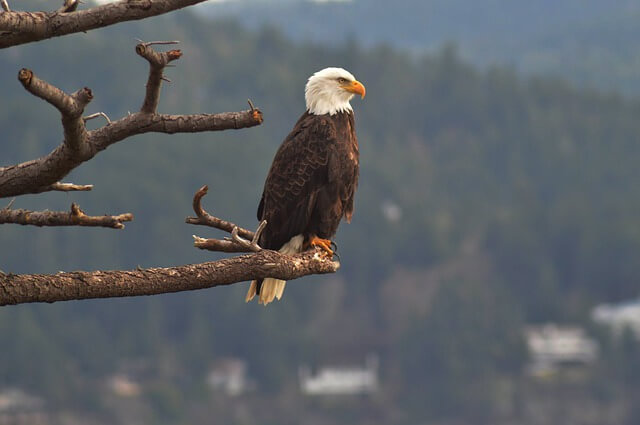
The Bald Eagle (Haliaeetus leucocephalus) is a majestic bird of prey and a symbol of American strength and freedom. In this section, we will delve into the fascinating characteristics of the Bald Eagle, an iconic and revered species.
Size and Appearance
The Bald Eagle is one of the largest birds of prey in North America. It has a distinctive white head and tail, contrasting with a dark brown body.
Adults typically have a wingspan of 6 to 7 feet, and their body length ranges from 28 to 40 inches.
Immature Bald Eagles have mostly dark plumage, gradually acquiring the iconic white head and tail as they mature.
Habitat and Distribution
Bald Eagles are primarily found in North America, inhabiting diverse environments such as forests, wetlands, and coastlines.
They are often associated with large bodies of water, such as rivers, lakes, and coastal areas, where they can find an abundant food supply.
Diet and Hunting Behavior
Bald Eagles are opportunistic hunters and feed mainly on fish. They have sharp, curved beaks and powerful talons, which enable them to grasp and carry prey.
While fish make up the majority of their diet, they are also known to feed on waterfowl, small mammals, carrion, and occasionally, they scavenge for food.
Migration Patterns
In Canada, Bald Eagles are known for their impressive migration patterns.
As winter approaches, Bald Eagles from breeding grounds in northern regions, including Alaska and parts of Canada, undertake long-distance migrations to more temperate areas in southern Canada and the United States.
The migration is driven by the need to find open water and abundant food sources during the colder months, when their breeding grounds become covered in ice or experience scarcity of prey.
These migratory journeys can span hundreds or even thousands of miles, with Bald Eagles navigating their way to wintering grounds where they can find suitable habitats and ample food resources.
Conservation Status and Recovery
The Bald Eagle was once on the brink of extinction due to factors such as habitat loss, hunting, and the use of pesticides like DDT.
However, concerted conservation efforts, including habitat protection, banning of harmful chemicals, and active management, have led to a significant recovery of Bald Eagle populations.
It was removed from the endangered species list in 2007 but remains protected under the Bald and Golden Eagle Protection Act and the Migratory Bird Treaty Act.
Conclusion
The Bald Eagle, with its distinctive appearance and ecological importance, remains an awe-inspiring and cherished species.
The successful recovery of Bald Eagle populations stands as a testament to the power of conservation efforts.
Understanding and appreciating the remarkable characteristics of the Bald Eagle allows us to honor and protect this majestic bird for generations to come.
The Sandhill Crane
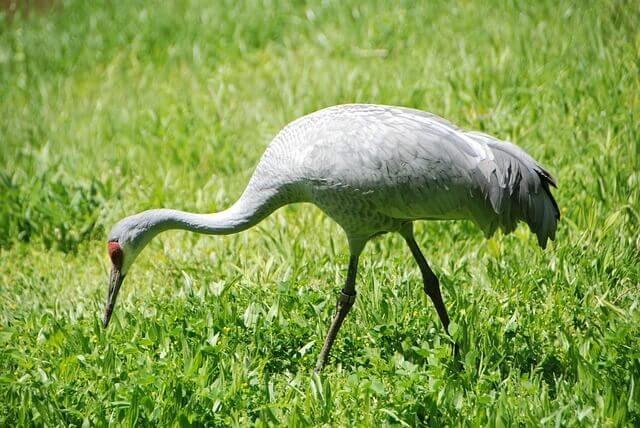
The Sandhill Crane (Antigone canadensis) is a majestic bird known for its distinctive appearance and captivating behaviors.
In this section, we will explore the fascinating characteristics of the Sandhill Crane, with a particular focus on its migration patterns into Canada.
Size and Appearance
The Sandhill Crane is a large bird with a height ranging from 3 to 5 feet. It has a wingspan of 6 to 7 feet and weighs between 6 and 14 pounds.
These cranes have long necks and legs, with a grayish body plumage. They exhibit a striking red forehead, a long dark bill, and prominent red patches on their cheeks.
Habitat and Distribution
Sandhill Cranes inhabit a variety of wetland habitats, including marshes, bogs, prairies, and grasslands.
They are widely distributed across North America, with breeding populations found in Alaska, Canada, and several northern U.S. states.
During migration, they can be seen in various regions of Canada.
Migration Patterns into Canada
Sandhill Cranes undertake remarkable seasonal migrations, including movements into Canada.
Breeding populations in northern regions, such as Alaska and parts of Canada, embark on extensive journeys to their wintering grounds in more southern regions.
These migrations often cover thousands of miles.
In Canada, Sandhill Cranes can be observed during their spring and fall migrations. As winter wanes, they begin their northward migration, returning to their breeding grounds in Canada.
The specific routes and timing of their migrations vary depending on the population and individual birds.
During these migrations, Sandhill Cranes form large flocks and navigate using prominent landmarks, celestial cues, and their innate sense of direction.
Their synchronized flight formations and distinctive calls make them a remarkable spectacle in the skies.
Conservation Status and Protection
Sandhill Cranes have experienced population declines in the past due to habitat loss and hunting. However, conservation efforts and habitat protection have contributed to the recovery of many populations.
The Sandhill Crane is protected under various conservation regulations and hunting restrictions to ensure its continued survival.
Conclusion
The Sandhill Crane’s majestic presence and remarkable migration patterns make it a captivating bird species.
Its journeys into Canada during spring and fall migrations showcase the species’ adaptability and the importance of preserving vital wetland habitats.
Understanding and appreciating the unique characteristics and conservation needs of the Sandhill Crane contribute to the conservation of this magnificent migratory bird for future generations to cherish.
The Tundra Swan
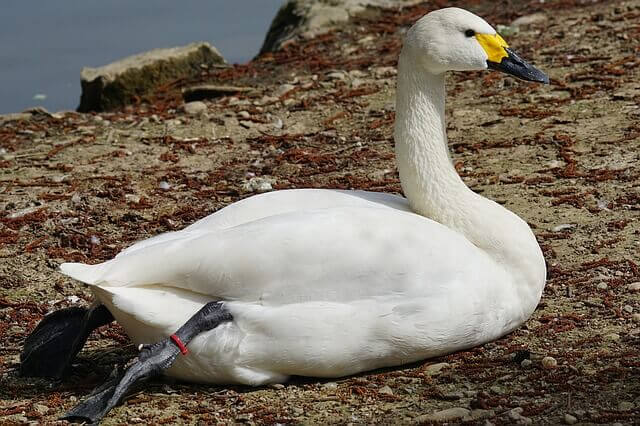
The Tundra Swan (Cygnus columbianus) is a magnificent bird known for its graceful presence and long-distance migrations.
In this section, we will explore the captivating characteristics of the Tundra Swan, with a specific focus on its remarkable migration patterns in Canada.
Size and Appearance
The Tundra Swan is a large waterfowl species with a wingspan ranging from 5 to 6.5 feet and a length of about 4 feet.
Adults have pure white feathers, a long neck, and a distinctive black bill with a small yellow spot near the eye. The young, known as cygnets, have a grayish plumage that gradually turns white as they mature.
Habitat and Distribution
During the breeding season, Tundra Swans can be found in the Arctic tundra regions of North America, including parts of Alaska and northern Canada.
They nest near freshwater lakes, ponds, and marshes, preferring areas with abundant aquatic vegetation for foraging.
Migration Patterns in Canada
Tundra Swans are renowned for their extensive annual migrations. In Canada, they undertake one of the longest bird migrations in North America.
As winter approaches and the Arctic breeding grounds freeze over, Tundra Swans embark on a remarkable journey southward, seeking more temperate habitats and open water areas.
The migratory route of Tundra Swans includes several key stopover sites in Canada, where they rest and refuel before continuing their journey.
Notable stopover locations include important wetlands and coastal areas along the Atlantic and Pacific flyways, such as the Fraser River Delta in British Columbia and the Bay of Fundy in Nova Scotia.
These resilient birds cover vast distances during their migration, with some individuals traveling over 3,000 miles.
Tundra Swans display strong fidelity to their migration routes, often returning to the same wintering and breeding grounds year after year.
Conservation Status and Protection
The Tundra Swan is protected under various conservation regulations in Canada.
The species is considered a sensitive species in some provinces and is subject to hunting regulations to ensure sustainable management.
Conservation efforts focus on preserving vital stopover habitats, protecting breeding areas, and monitoring population trends.
Ecological Significance
Tundra Swans play a significant ecological role in their breeding and wintering habitats.
They contribute to seed dispersal and nutrient cycling as they forage on aquatic vegetation, helping to maintain the health and biodiversity of wetland ecosystems.
Additionally, their annual migrations connect diverse habitats, making them essential for the movement of energy and resources across vast landscapes.
Conclusion
The Tundra Swan, with its elegant appearance and epic migrations, represents a remarkable avian species in Canada.
The awe-inspiring journey of Tundra Swans from their Arctic breeding grounds to wintering areas in Canada, demonstrates their remarkable adaptability and endurance.
By understanding and appreciating their migration patterns, we can strive to protect and preserve the habitats they rely on, ensuring the continued presence of these graceful birds for future generations to admire and cherish.
The Trumpeter Swan
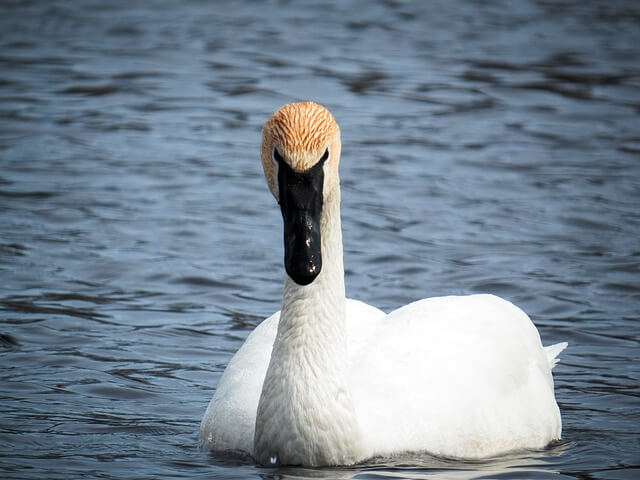
The Trumpeter Swan (Cygnus buccinator) is a majestic waterfowl species known for its elegance and distinctive trumpet-like call.
In this section, we will explore the captivating characteristics of the Trumpeter Swan, with a particular focus on its migration patterns in Canada.
Size and Appearance
The Trumpeter Swan is one of the largest waterfowl species in the world. It boasts an impressive wingspan that can reach up to 8 feet, and adult individuals can measure up to 4.5 feet in length.
These swans exhibit a graceful presence with their pure white plumage, long necks, and strikingly orange bill.
Habitat and Distribution
Trumpeter Swans can be found across North America, with significant populations in Canada.
During the breeding season, they inhabit freshwater wetlands, lakes, and rivers, where they build large nests made of plant materials.
In winter, they migrate to more temperate regions, including parts of Canada, seeking open water and food resources.
Migration Patterns in Canada
Canada plays a crucial role in the migration of Trumpeter Swans.
As the seasons change and colder temperatures approach, these magnificent birds embark on remarkable journeys from their breeding grounds in northern regions to wintering sites in southern Canada.
During migration, Trumpeter Swans rely on a network of wetlands and water bodies along their flight path, where they can rest and feed along the way.
The specific routes and destinations can vary depending on factors such as weather conditions and food availability.
The migration distances covered by Trumpeter Swans can be extensive, with some individuals traveling hundreds or even thousands of miles to reach their preferred wintering areas in Canada.
These wintering sites provide essential resources such as open water and aquatic vegetation, ensuring their survival during the harsh winter months.
Conservation and Protection
Trumpeter Swans faced significant population declines in the past due to overhunting and habitat loss. However, dedicated conservation efforts have led to their recovery in many regions.
Strict regulations, habitat preservation, and restoration initiatives have helped protect critical stopover sites and wintering habitats for Trumpeter Swans in Canada.
Today, these magnificent birds are considered a conservation success story, with increasing populations and successful breeding efforts.
Ongoing monitoring and conservation programs continue to play a vital role in ensuring the long-term survival of Trumpeter Swans and their migratory journeys in Canada.
Conclusion
The Trumpeter Swan, with its grandeur and remarkable migration patterns, holds a special place in Canada’s natural heritage.
Observing these graceful birds in flight and witnessing their seasonal movements is a testament to the beauty and resilience of our natural world.
By protecting their habitats and fostering conservation efforts, we can help ensure that future generations can appreciate the timeless beauty of the Trumpeter Swan and the significance of its migratory journeys in Canada.
The American White Pelican
The American White Pelican (Pelecanus erythrorhynchos) is a magnificent waterbird known for its impressive size and graceful flight.
In this section, we will explore the captivating characteristics of the American White Pelican, with a particular focus on its remarkable migration patterns in Canada.
Size and Appearance
The American White Pelican is one of the largest bird species in North America, with a wingspan reaching up to 9 feet and a length of about 4 to 5 feet.
It has striking white plumage, with black flight feathers visible when in flight. During the breeding season, adult pelicans develop a distinct horn-like projection on their bills.
Habitat and Distribution
American White Pelicans can be found across North America, including parts of Canada. They inhabit a variety of aquatic habitats such as freshwater lakes, marshes, and reservoirs.
In Canada, they are commonly found in regions with suitable breeding grounds and abundant food sources, particularly in the Prairie Provinces and parts of British Columbia.
Diet and Feeding Behavior
These pelicans are primarily fish-eaters, utilizing their unique feeding strategy to catch prey. They forage cooperatively, forming groups and herding fish towards shallower waters.
With their expandable throat pouches, they scoop up fish and water, then strain out the water, allowing them to swallow their catch. They also feed on amphibians and occasionally consume small mammals.
Migration Patterns in Canada
The American White Pelican is renowned for its impressive migratory behavior. In Canada, these pelicans undertake extensive north-south migrations, covering vast distances between breeding and wintering grounds.
During the summer breeding season, they can be found in various regions of Canada, including Alberta, Saskatchewan, Manitoba, and parts of British Columbia.
However, as winter approaches and the availability of food decreases, the pelicans embark on their migratory journey.
Canadian populations of American White Pelicans typically migrate to warmer regions in the southern United States and Mexico, where food resources are more abundant during the winter months.
Some pelicans may travel even farther to Central and South America.
Their migration routes often follow major water bodies, such as the Mississippi Flyway, ensuring access to suitable stopover sites for resting and feeding along the way.
These migratory journeys can cover several thousand miles, with pelicans relying on their impressive flying abilities to navigate and complete the arduous journey.
Conservation Status and Protection
The American White Pelican is a species of least concern in terms of conservation status, as populations are generally stable.
However, they face threats such as habitat loss, pollution, and disturbance at nesting and foraging sites.
Conservation efforts focus on protecting their breeding habitats, managing human activities in critical areas, and monitoring population trends.
Conclusion
The American White Pelican’s migratory behavior adds to its allure and highlights its remarkable adaptability.
Understanding the migration patterns of these majestic birds in Canada enhances our appreciation for their ecological significance and underscores the need to conserve their habitats along their migratory routes.
By protecting their breeding grounds and wintering sites, we can ensure the continued survival and well-being of the American White Pelican for future generations to marvel at their beauty and grace.
The Whooping Crane
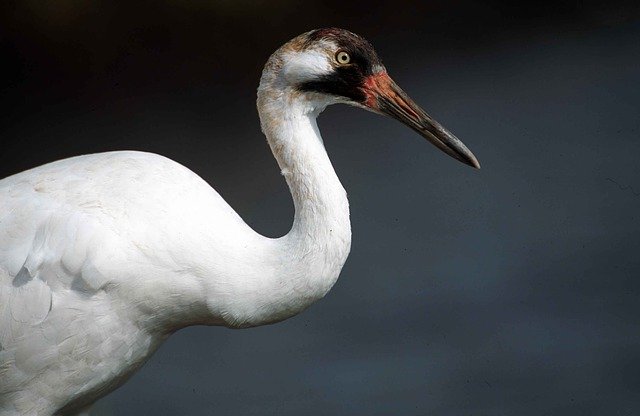
The Whooping Crane (Grus americana) is an iconic and endangered bird species known for its majestic appearance and remarkable migratory patterns.
In this section, we will explore the characteristics and captivating migration of the Whooping Crane.
Size and Appearance
The Whooping Crane is one of the tallest bird species in North America, standing at an impressive height of around 5 feet. It has a wingspan of about 7.5 feet, making it one of the largest flying birds on the continent.
With its striking white plumage, black wingtips, and a patch of red on its crown, the Whooping Crane is an extraordinary sight to behold.
Habitat and Distribution
During the breeding season, Whooping Cranes can be found in the wetlands and marshes of Canada’s Wood Buffalo National Park in northern Alberta and the surrounding regions.
This serves as their primary nesting habitat. As the seasons change, they embark on an extraordinary journey, migrating to their wintering grounds.
Migration Patterns in Canada
The Whooping Crane is renowned for its impressive migratory journey, which covers thousands of miles.
After the breeding season in Canada, the cranes undertake a remarkable migration to their wintering grounds in the United States, particularly along the Gulf Coast of Texas.
The migratory route of the Whooping Crane includes several crucial stopover sites in Canada, where they rest and refuel during their long journey.
The cranes follow specific flyways, taking advantage of favorable wind conditions and suitable habitat along their route.
The migration of the Whooping Crane is a captivating spectacle, with the birds flying in a characteristic V-formation, using thermals and updrafts to conserve energy during their arduous journey.
They navigate with precision, relying on innate instincts and learned routes passed down from generation to generation.
Conservation Efforts and Challenges
Conservation efforts by organizations and governments aim to protect critical habitats, restore wetlands, and raise awareness about the importance of preserving this magnificent species.
By tracking and studying the migration patterns of Whooping Cranes, researchers can gather valuable data that helps inform conservation strategies and monitor the health of the population.
Efforts such as habitat restoration, captive breeding programs, and community involvement are crucial in safeguarding the future of this iconic species.
Conclusion
The Whooping Crane’s migratory journey showcases their resilience and adaptability. Their epic migrations across Canada and the United States inspire awe.
By understanding their habitat needs and challenges, we appreciate the importance of conservation efforts.
With dedication, we can ensure the survival and recovery of the Whooping Crane for future generations to cherish.

